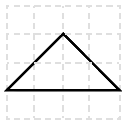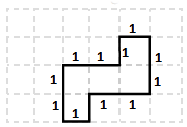Class 5 Maths Chapter 11 Important Question Answers - Chapter 11 - Area and its Boundary
Q1: Find the areas of the following figures by counting square.
Ans: The figure contains 2 fully filled squares and 4 half-filled squares. Therefore, the area of this figure will be 4 square units.
Q2: Find the areas of the following figures by counting square.
Ans: The figure contains 10 fully filled squares only. Therefore, the area of this figure will be 10 square units.
Q3: Find the perimeter of the above figure if each square has an edge of 1 cm.
Ans: As from the figure we can see, the perimeter of the figure is (1 cm × 12) = 12 cm
Q4: Find the areas of the following figures by counting the square.
Ans: The figure contains 2 fully filled squares and 4 half-filled squares.
total squares = 2 full squares + 4 x half squares = 2 full squares + 2 full squares = 4 full squares
Therefore, the area of this figure will be 4 square units.
Q5: The region given in figure is measured by taking each rectangular box as a unit. What is the area of the region?
Ans: Area of 1 small rectangle = 1 square unit
Total number of small rectangles = 13
∴ Area of region = Total number of small rectangles × Area of 1 small rectangle
= (13 × 1)
= 13 square units
∴ Area of the region is 13 square units
Q6: Find the areas of the following figures by counting the square.
Ans: The figure contains 5 fully filled squares only. Therefore, the area of this figure will be 5 square units.
Q7: A wire is in shape of a rectangle. Its length is 40 cm and breadth is 22 cm . If the same wire is reshaped into a square, what will be the measure of each side. Also find which shape encloses more area.
Ans: Given,
Length of rectangle(l) = 40 cm
Breadth of rectangle(b) = 22 cm
Perimeter of rectangle = 2(l + b)
= 2(40 + 22) cm
= 124 cm
It is reshaped into square
∴ Perimeter remains same
Let, the edge of square be a
∴ 4a = 124
⇒ a = 31
Hence, the side of square is 31 cm.
Area of rectangle = l x b
= 40 × 22 sq. cm
= 880 sq. cm
Area of square= Side x Side
= 31 x 31 sq. cm
= 961 sq. cm
Hence, the square encloses more area.
Q8: What is the area of the triangle?
Ans: area of the triangles in the first figure will be 2÷ 2 = 1sq cm
since the figure consists of two square boxes each having area of 1 sq cm
Area of triangles in second figure will be 6 ÷ 2 = 3sq cm
since the figure contains 6 square boxes
Area of triangles in third figure will be 12 ÷ 2 = 6sq cm
since the figure contains 12 square boxes
Q9: Which stamp has biggest area?____________________ ?
Ans: A is the answer which has a biggest area.
Q10: What is the difference in the area of biggest and smallest stamp?
Ans: Stamp A covers 6 squares, Stamp C cover 1 square , Stamp B covers 2 squares and Stamp D covers 4 squares.
So, the area of biggest stamp, stamp A = (6 × 1) = 6 square cm
And ,the area of smallest stamp ,stamp C = (1 × 1) = 1 square cm
Difference in the area of the biggest and smallest stamp
= (6 − 1) = 5 square cm
|
31 videos|192 docs|41 tests
|





















